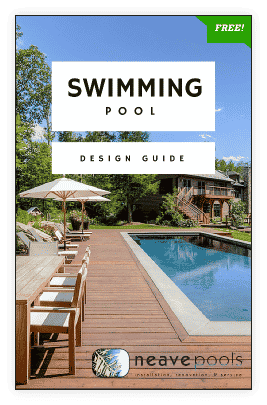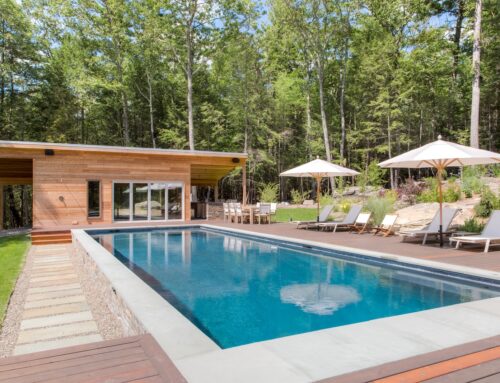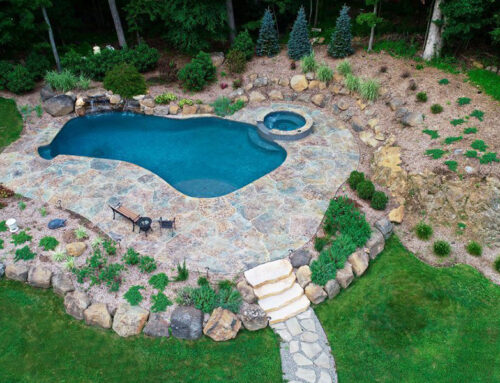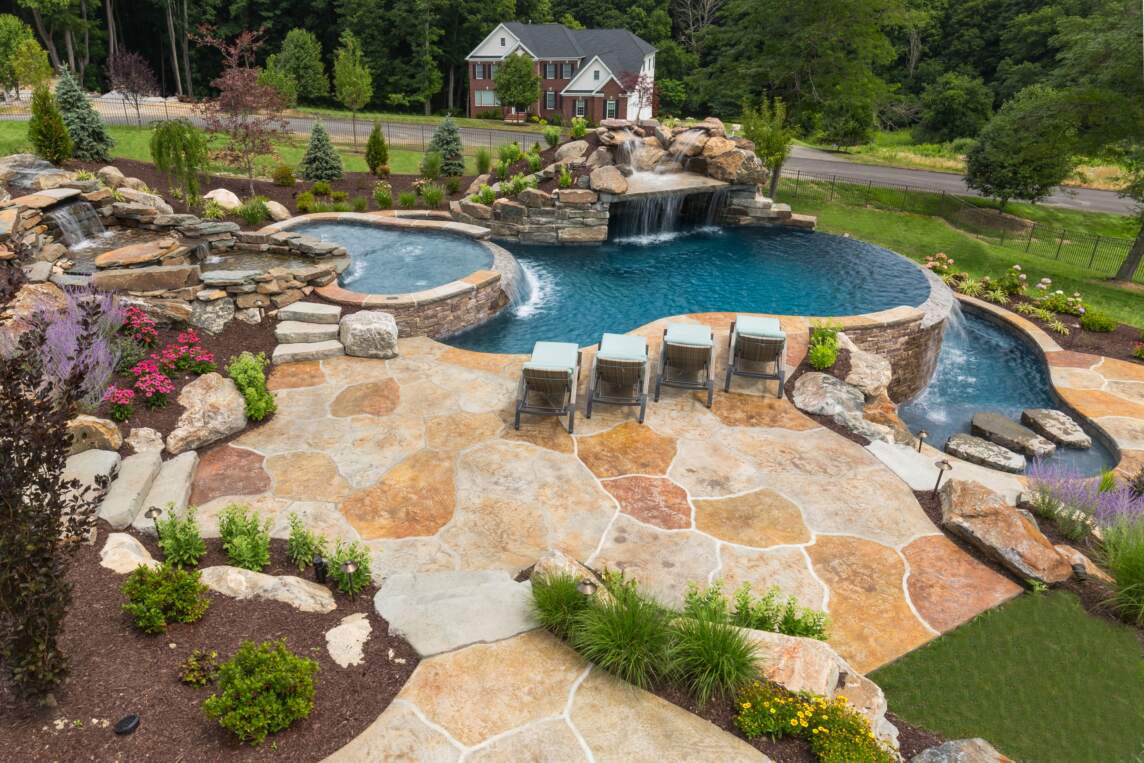
When you’re designing a new backyard swimming pool, it’s pretty tough not to get completely carried away dreaming up fun pool design ideas like water-slides, diving boards and other pool water features you’d build up around your backyard pool to create the ultimate home water-park.
But there are actually practical considerations to be made before you can channel your inner child and create a personal Splash Down Beach just steps from your back door – such as the material you’ll use to pave the landscaping area around your in-ground pool.
There are plenty of choices here for your swimming pool deck, and each has upsides and downsides: aesthetic, budgetary and everything in between. Here’s a look at some of the most common options for pool deck pavers and surfaces:
Concrete pool deck
A concrete pool deck can be more cost-effective. No matter your budget, you can create a high-quality concrete pool deck that suits your needs, from plain gray, like a sidewalk, to a decorative, stamped concrete slab pool deck in any pattern and color scheme. Architectural stamped concrete, a higher end option, really stands out.
It’s also environmentally conscious, as concrete is always available locally – cutting down on transportation costs and pollution – and is made from limestone, an abundant natural resource. Plus, it’s easy to take care of. A concrete pool deck is durable and only needs to be resealed every two or three years.
The downside of any type of concrete: It can crack, no matter how well it was initially installed and how many joints were put in place to prevent them. A concrete pool deck can also not be slip-resistant when wet, depending on the finish – something to consider if you have kids running around the pool area!
Natural stone pool deck
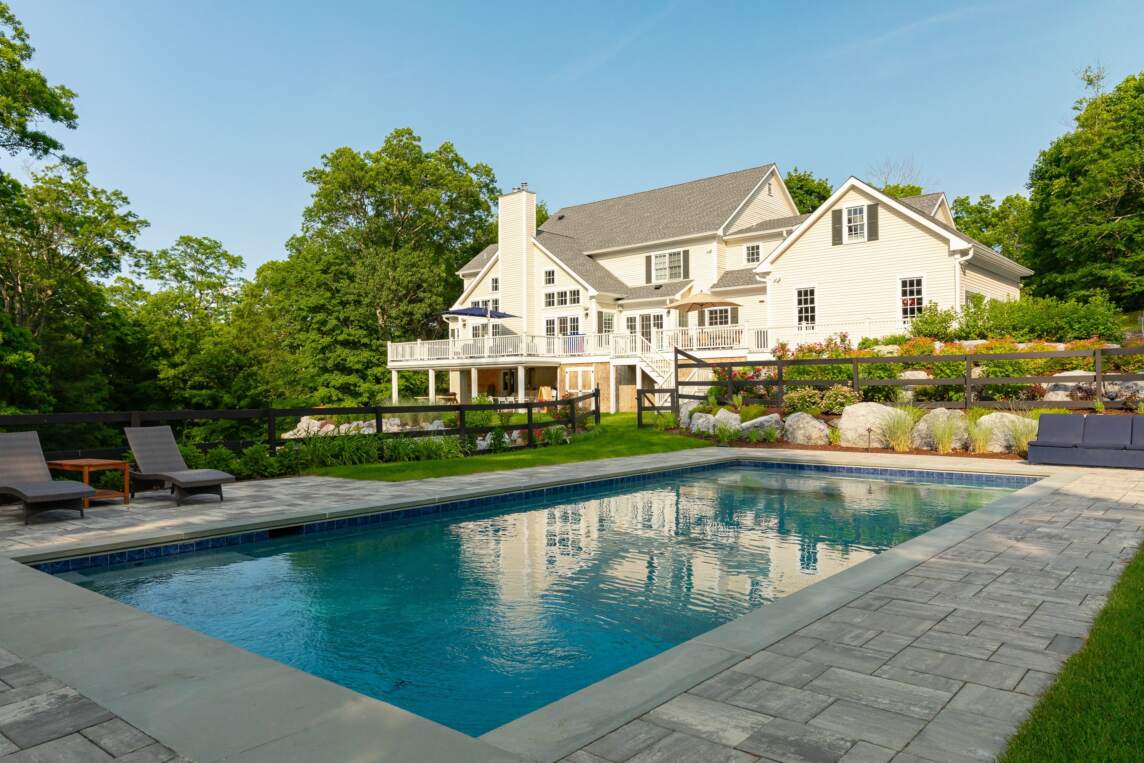 There are a lot of options when it comes to natural stone. An irregular flagstone pool deck can create a gorgeous, natural, rugged look with a lot of personality, while dimensional stone has been specially selected and treated to be a specific size and shape for its use, making it much more precise when installed. The biggest benefit of these pool deck materials is the design freedom you’ll have in creating your pool decking and surface.
There are a lot of options when it comes to natural stone. An irregular flagstone pool deck can create a gorgeous, natural, rugged look with a lot of personality, while dimensional stone has been specially selected and treated to be a specific size and shape for its use, making it much more precise when installed. The biggest benefit of these pool deck materials is the design freedom you’ll have in creating your pool decking and surface.
If the natural stone pavers have been installed properly, it will last a long time and won’t crack like concrete tends to. The design can be scaled fairly seamlessly, too; additional stone can be added and fanned out around the perimeter to create a larger outdoor living pool area.
Natural paving stones can get expensive if you’re installing it everywhere – limiting your natural stone use to just the pool coping around the edge can help you stay on budget. Cost is also impacted by your decision to “dry lay” the stone on a crushed stone and sand base or by mortaring it on a concrete base. The dry-laid approach is more cost-effective.
Natural stone also can shift and move over time, especially in areas where there’s extensive grading or back-fill during excavation. And weeds can grow up among the stones (if dry-laid), which can be unsightly if you want a super-clean look for your pool deck surface.
Brick paver pool deck
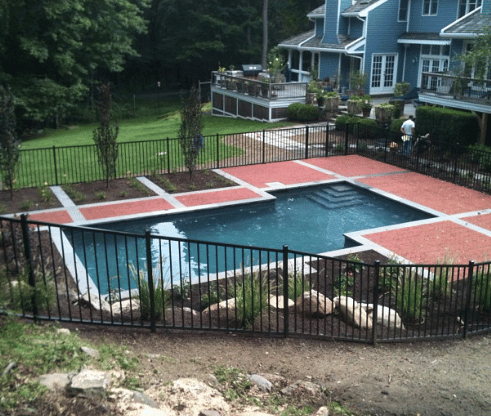 Brick is a classic look that’s beautifully suited to many surfaces, including pool decks. In addition to the variations in bricklaying patterns – and the design freedom that offers – you also have a choice between concrete and clay pavers for your swimming pool deck. Concrete brick pavers come in many different shapes, from standard rectangles to triangles and hexagons, as well as different colors, from grays and browns to true red. Clay pavers are manufactured in the traditional rectangular shape. While concrete pavers give you more landscape design flexibility, clay pavers offer a more traditional, classic look.
Brick is a classic look that’s beautifully suited to many surfaces, including pool decks. In addition to the variations in bricklaying patterns – and the design freedom that offers – you also have a choice between concrete and clay pavers for your swimming pool deck. Concrete brick pavers come in many different shapes, from standard rectangles to triangles and hexagons, as well as different colors, from grays and browns to true red. Clay pavers are manufactured in the traditional rectangular shape. While concrete pavers give you more landscape design flexibility, clay pavers offer a more traditional, classic look.
Brick can be a bit more expensive for homeowners than other pool deck surfaces and pool paver options because of the labor required to install it, and it’s also prone to shifting and breakage. But it can be long lasting and provides a classic and elegant look to your modern swimming pool outdoor space.
Brick’s biggest pitfall in a poolside application is heat retention. If your pool is in full sunlight, there’s a chance you might burn your feet when you step out of the water on a smoldering hot day!
Before calling on your inner child to dream up your new inground swimming pool, consider the advantages and disadvantages to each of these pool deck surfaces and paving options. If you feel the need to consult more than your inner child, give our expert pool designers at Neave Pools a call. We’re here to make your luxury swimming pool dreams a reality.
